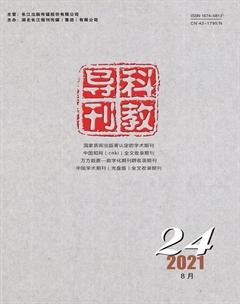“先入”勿“为主”
李德强
我們先来看一个例子:
从1986年的自然教学大纲到2017年的小学科学课程标准,“溶解”一直都被列为学习内容,尽管不同阶段对其学习的要求有一些变化,但认识溶解始终是重点。
从各种渠道收集了“溶解”内容的多个教学案例,发现在长达30年的教学发展中,这一课的“设计”并没有太大的改变。其教学过程大致是这样的:将一种物质放入水中(以食盐为例),观察并提出问题:食盐到哪里去了?接下来研究食盐是怎样“不见的”。具体做法是将食盐、石子、糖等物质放进水中,通过观察、描述、比较其变化过程,初步形成“食盐是怎样不见的”的结论,然后借助有色物质(如高锰酸钾)的溶解过程,仔细观察其由“看得见的颗粒”变成“看不见的微粒”的过程,从而更进一步认识物质在水中的溶解。在课的最后,还会将多种物质的溶解状况进行比较,在辨别中加深对溶解的理解。
上述流程基本是按照“观察—比较—分析—抽象—概括”的过程展开的。在引导认识溶解现象的过程中,可谓步步为营,达成目标。从面上来看,并没有什么大的问题,但如果仔细考问,就会发现其“先入”且“为主”的特征十分明显。
在前述过程中,当学生讲到“盐看不见了”时,教师就会理所当然地采取与石子比较、借助有色物质的溶解过程来证明“盐的确化成了看不见的微粒”。教师为什么会采取这些方式和方法来展开这一教学过程呢?其中一个主要原因就是,教师是知道在小学阶段对溶解的描述的,其核心要点包括两个方面:一是物质变成了看不见的微粒,另一个是这些微粒均匀地分散在水中。采用石子和有色物质作为对比材料正好对应了这两点,这就是“先入”的知识起作用了,使得教师自然而然地牵着学生奔着这两点知识而去,省掉了许多探究前的思维活动,比较顺利地得到了溶解的概念。但从众多辨别物质在水中是否溶解的情况来看,学生的认识其实是模棱两可的,要么说不清楚,要么呆板地对照概念进行比较,“溶解”并没有在学生的头脑中真正建构起来,可见“为主”替代了学生的思维,使得探究实践的价值“知识化”了。
那么,“先入”却不“为主”的教学呈现可能是什么样的呢?我们可以假想一下,如果教师自己也不知道“溶解”是怎么回事,当他和学生一起发现了“盐在水中不见了”的现象时,他该如何运用自己的科学能力引导学生将探究实践进行下去呢?或许,首先要想办法证明盐的确还在水中而不是跑到别处去了;其次要引导学生思考,“看不见的盐”在水中会以一种什么样的状态存在呢?可以通过画一画、用模拟的颗粒摆一摆等多种形式提出自己的解释,发表自己的观点,但并不是你的观点就能得到大家的认可,所以最后还得想办法来证明自己观点的合理性、正确性等,于是学生的探究实践活动也就深入进去了,其自主性、能动性也就产生了。对于学生而言,能提出的观点和想到的证明方法可能非常有限,这时就需要教师展现引导者作用了。
可见,“先入”且“为主”与“先入”却不“为主”所产生的是两种完全不一样的教学路径,前者往往过多地依赖自己已有的知识,将教学过程细化为得到既有结论的若干个环节,其目的就是奔着最后的结论而去的。后者则不一样,是依据对现象的观察,运用多种方式方法展开的探究实践,其目的是寻求证据,建构观点。从学科核心素养培养的角度看,“先入”却不“为主”能让教师走近学生的探究世界,看到他们的可能性、成长性。这不仅能激发学生的创新潜能,使教学变得智慧而生动,而且能使学生在科学观念、科学思维、科学实践等多方面得到良好发展。
Don’t be Preconceived
LI Deqiang
中图分类号:G424文献标识码:ADOI:10.16400/j.cnki.kjdk.2021.24.003
LI Deqiang
Deputy Editor in Chief of Science Textbook of People’s Education Hubei Education Press
Vice Chairman of Primary School Science Teaching Steering Committee of Hubei Provincial Department of Edu‐cation
Excellent Expert in Yichang City, Hubei Province
Let’s take a look at an example:
From the nature syllabus in 1986 to the primary school science curriculum standard in 2017, "dissolu? tion" has always been listed as the learning content. Although there are some changes in the learning re? quirements at different stages, the understanding of dissolution has always been the focus.
Severalteachingcasesof"dissolving"content are collected from various channels. It is found that the "design" of this course has not changed much in the 30-year teaching development. The teaching pro? cess is roughly like this: put a substance into water(take salt as an example), observe and ask the ques? tion: where is the salt? Next, study how salt is "in? visible". The specific method is to put salt, stone, sugar and other substances into water, preliminarily form the conclusion of "how salt is invisible" by ob? serving, describing and comparing their change pro? cess,andthencarefullyobservetheprocessfrom"visibleparticles"to"invisibleparticles"withthe help of the dissolution process of colored substances(such as potassium permanganate), So as to further understand the dissolution of substances in water. At the end of the class, we will compare the dissolution of various substances to deepen the understanding of dissolution in discrimination.
The above process is basically carried out ac? cordingtotheprocessof"observation-comparisonanalysis-abstraction-generalization". In the process of guiding the understanding of dissolution phenomenon, it can be said to achieve the goal step by step. Gen? erally speaking, there is no big problem, but if you ask carefully, you will find that its "first in" and"main" characteristics are very obvious.
Intheaboveprocess,whenthestudentssay that "salt is invisible", the teacher will naturally com? pare it with stones and prove that "salt has indeed turned into invisible particles" with the help of the dissolutionprocessofcoloredsubstances.Whydo teachers adopt these ways and methods to carry out this teaching process? One of the main reasons is that teachers know the description of dissolution in primary school, and its core points include two as? pects: one is that substances become invisible parti? cles, and the other is that these particles are evenly dispersed in water. The use of stones and colored ma? terials as comparative materials just corresponds to these two points, which is that the "first in" knowl? edge works, which makes the teacher naturally lead the students to run towards these two points of knowl? edge, saves many thinking activities before explora? tion, and obtains the concept of solution smoothly. However, judging from many situations of distinguish? ing whether substances are dissolved in water, stu? dents’ understanding is actually ambiguous, either un? clear or rigid comparison with concepts. "Dissolution" is not really constructed in students’ minds. It can be seen that "main" replaces students’ thinking, mak? ing the value of inquiry practice "intellectualized".
So what is the possible presentation of "first in" but not "main" teaching? We can imagine that if the teacher doesn’t know what "dissolution" is, how can he use his scientific ability to guide the students to carry on the exploration practice when he and the students find the phenomenon of "salt missing in the water"? Perhaps, first of all, we should find a way to prove that the salt is still in the water instead of go? ing elsewhere; Secondly, we should guide students to think about what kind of state "invisible salt" will ex? ist in water? You can put forward your own explana? tion and express your own views in various forms such as drawing a picture and using simulated parti? cles to swing, but your views can not be recognized by everyone, so you have to find ways to prove the rationality and correctness of your views. Therefore, students’ exploration and practice activities will go deep into it, and their autonomy and initiative will be produced. For students, the ideas they can put for? ward and the proof methods they can think of may be very limited. At this time, teachers need to show the role of guides.
It can be seen that "first in" and "main" and"first in" but not "main" produce two completely dif? ferentteachingpaths.Theformeroftenreliestoo muchontheirexistingknowledgeandrefinesthe teaching process into several links to get the existing conclusion, with the purpose of running towards the final conclusion. The latter is different. It is an inqui? ry practice based on the observation of phenomena and using various ways and methods. Its purpose is to seek evidence and construct views. From the per? spective of discipline core quality training, "first in" but not "main" can let teachers approach students’ explorationworldandseetheirpossibilityand growth. This can not only stimulate students’ innova? tive potential and make teaching intelligent and viv? id, but also make students develop well in scientific concept, scientific thinking, scientific practice and so on.

